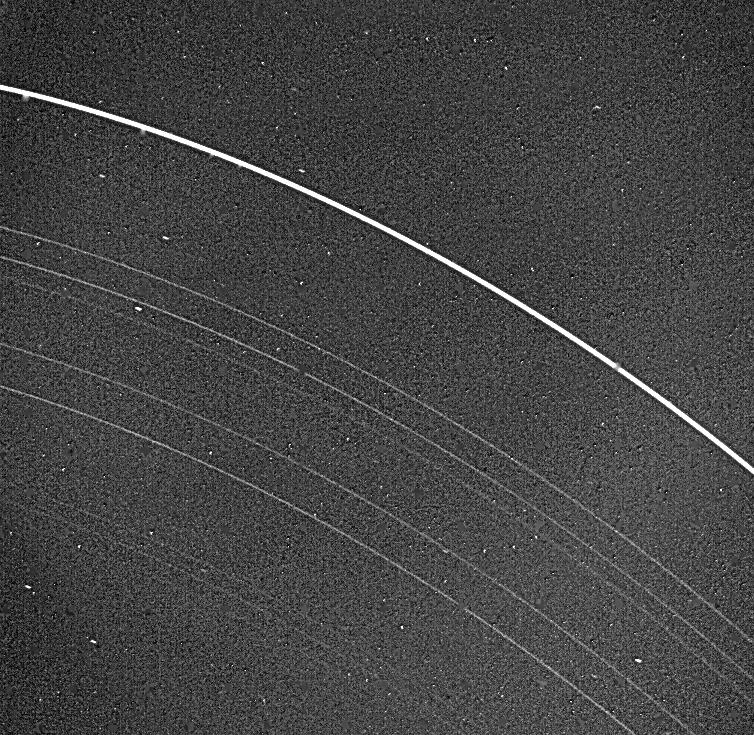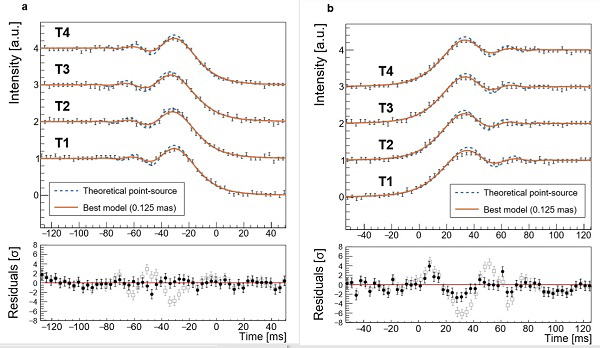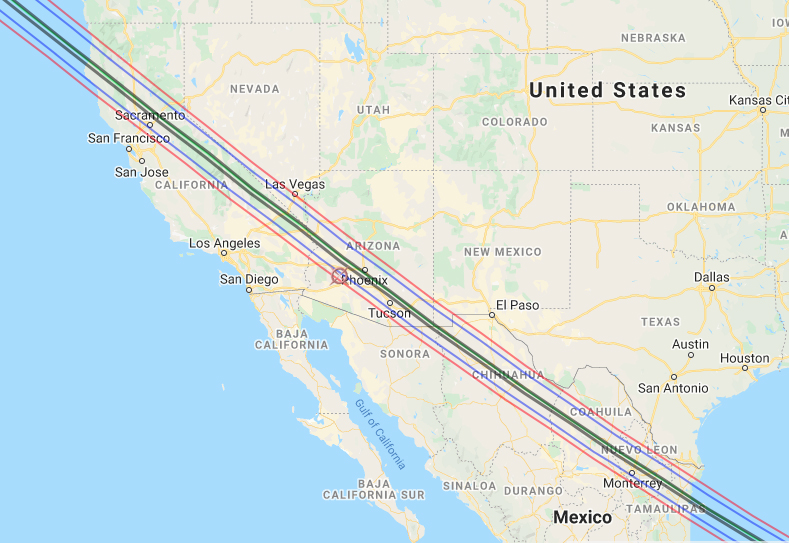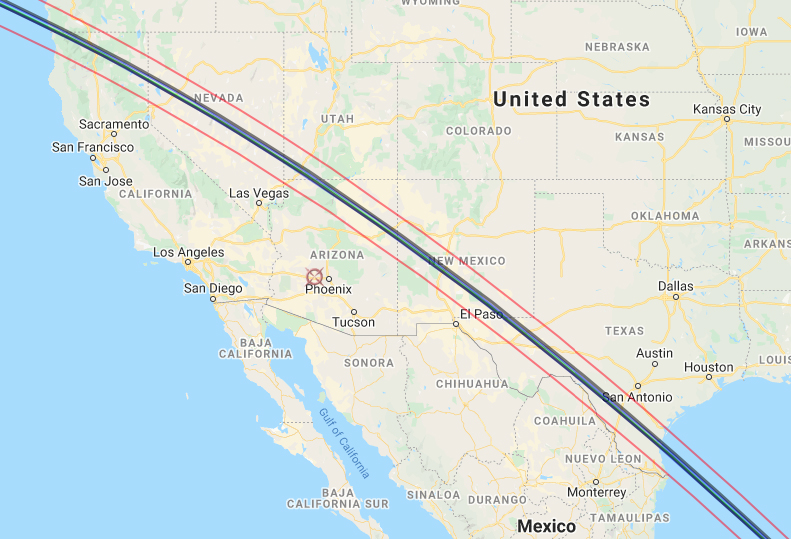
In astronomy, an occultation – which comes from Latin words meaning “to hide” – occurs when one body passes in front of, and thus for a time hides, another body. (In this context, a solar eclipse can be considered as a kind of occultation.) In its most common usage, an occultation usually refers to the moon passing in front of a star, or sometimes a planet, but on rarer occasions it can also refer to a planet passing in front of a background star. While such an event can be a fascinating thing to observe for its own sake, occultations are also useful for scientific purposes.
On March 10, 1977, the planet Uranus was predicted to occult the 9th-magnitude star HD 128598 in Libra. A team of astronomers was using the Kuiper Airborne Observatory to observe the occultation with the intent of determining information about Uranus’ atmosphere, however before the star passed behind Uranus it briefly disappeared and reappeared several times, and then did so again after re-emerging from behind Uranus. The rather surprising conclusion was that Uranus is accompanied by a system of thin rings, which was verified in early 1986 when the Voyager 2 spacecraft flew by Uranus.
This incident produced an almost paradigmatic shift in thinking; up until that time Saturn was the only object in the solar system that was believed to have rings. This event showed that at least one other planet also has rings, and indeed, primarily as a result of spacecraft visits we now know that Jupiter and Neptune have systems of rings as well. In fact, as a result of this discovery of rings around Uranus special efforts were made to find rings around Neptune, and on May 24, 1981, a team from Villanova University detected an occultation event that was at first suspected to be due to a ring but which turned out to be a fortuitous occultation by the moon Larissa (Neptune VII), which was re-discovered by Voyager 2 when it flew by that planet in 1989. (Some faint ring arcs around Neptune were later suspected in 1984 and confirmed by the Voyager 2 encounter five years later.) More recently, when the centaur (10199) Chariklo occulted a star on June 3, 2013, that star underwent a series of disappearances and reappearances that showed that Chariklo is accompanied by a pair of thin rings. (Centaurs are the subject of a previous “Special Topics” presentation.)

Another interesting example of a science result from an occultation occurred when Pluto occulted a 12th-magnitude star on June 9, 1988. Instead of disappearing and reappearing almost instantaneously, the star disappeared gradually and reappeared gradually as well, indicating the presence of an atmosphere. At that time Pluto was just a little over a year away from its perihelion passage, and the appearance of at least a temporary atmosphere was perhaps not especially surprising; nevertheless, this was the first definite detection of such an atmosphere.
Since planets can occult stars, it would also be logical to presume that asteroids can occult stars as well. However, given the typical asteroid’s small size, such events would only be visible only along narrow strips of Earth’s surface – akin to the path of a total or annular solar eclipse – and would be brief, lasting not more than a few seconds. Predicting such an event requires accurate and precise knowledge of both an asteroid’s orbit and the location of the star to be occulted, and because of this the first attempts at observing asteroid occultations were pretty much hit-or-miss affairs; the first attempt to observe an occultation by an asteroid took place on February 19, 1958, when the main-belt asteroid (3) Juno occulted the 9th-magnitude star HD 32203 in Orion; there was one positive report of detecting this event but this turned out to be an apparent false alarm. The first successfully observed occultation by an asteroid took place on October 2, 1961, when (2) Pallas occulted the 9th-magnitude star HD 215764 in Aquarius; positive detections were reported from South Africa and from India.
For the next couple of decades a handful of additional occultations by asteroids were observed around the world, although such was the state of the knowledge of asteroids’ orbits and stars’ positions that several predicted events ended up taking place at significant distances from the expected locations. One particularly notable occultation took place on the evening of January 23, 1975, when the near-Earth asteroid (433) Eros – the subject of a previous “Special Topics” presentation – occulted the 4th-magnitude star Kappa Geminorum. While the event was successfully observed from several locations within the northeastern U.S., the constant “touch-and-go” state of the predicted path illustrated the difficulties inherent in making such predictions.

The art of predicting occultations by asteroids has improved greatly since those days. This is in significant part due to the precise positions of stars provided by ESA’s Hipparcos mission in the late 1980s and early 1990s, and the present ESA Gaia mission; not only have these two missions provided very precise and accurate positions of stars, they have also helped to increase dramatically the accuracy of astrometry of asteroids and other solar system bodies. This in turn has helped in providing accurate orbits for these objects. As a result, predictions of the paths of occultations by asteroids today are generally quite accurate.
With the large number of asteroids that are known nowadays, several occultations by asteroids are usually predicted to occur on any given day. Depending upon the brightness of the star and the brightness difference between the star and the occulting asteroid, the events can be rather dramatic to witness, with a star essentially “winking out” for up to several seconds before reappearing. I have successfully witnessed one such event: on June 12, 2013 I watched the 6th-magnitude star HD 156026 in Ophiuchus disappear for four seconds when it was occulted by the main-belt asteroid (332) Siri.
The improved accuracy of occultation predictions available nowadays in turn allows for useful scientific observations to be conducted during these events. Especially when equipped with high-speed video-recorders that are accurately time-tagged, a team of observers placed along a line across the path of an occultation can determine the size and shape of the occulting asteroid by recording precise times of the star’s disappearance and reappearance. In this manner we have successfully determined the shapes and sizes of numerous asteroids, all the way from near-Earth space out to the Kuiper Belt. In addition, the presence of moons or other companion objects can be gleaned as well; several asteroids’ moons have in fact been discovered during occultation events.
With modern telescopes it is also possible nowadays to determine information about the occulted stars from occultation events. On two occasions in 2018 – February 22, involving the main-belt asteroid (1165) Imprinetta, and May 22, involving the main-belt asteroid (201) Penelope – the paths of an occultation passed directly over the Very Energetic Radiation Imaging Telescope Array System (VERITAS) telescope in Arizona. VERITAS is an array of four 12-meter antennas sensitive to high-energy radiation (produced by gamma-rays in the atmosphere) that is capable of taking hundreds to thousands of exposures per second. By examining the stars’ diffraction fringes as the asteroids were occulting them, VERITAS was able to produce accurate size determinations of the stars in question: 11 times the sun’s diameter for the Imprinetta event (for a star over 2600 light-years away) and slightly over twice the diameter of the sun for the Penelope event (for a star 700 light-years away). This type of observation is not available for most asteroid occultations – since VERITAS and telescopes of its nature are not transportable – but the construction of additional large telescopes within the foreseeable future suggests that additional opportunities for investigations like these may increase over time.

Throughout “Ice and Stone 2020” I am listing – within the weekly “This Week in History” pages – those occultations by asteroids this year that involve relatively bright stars (7th magnitude and brighter) and/or others that might be interesting in some way. Two such events take place next week, both of which are visible from close to my part of the world. On May 11 the main-belt asteroid (363) Padua will occult the 5.5-magnitude star Psi Cancri; the predicted path of the occultation crosses eastern California from northwest to southeast, then crosses central Arizona (including over the cities of Phoenix and Tucson) and northern Mexico (the city of Chihuahua is just outside the predicted path, while Monterrey is just within it). The occultation will occur around 5:15 UT and will last up to three seconds; the drop in the star’s brightness will be over 8 magnitudes.
A perhaps even more interesting occultation occurs the following day, May 12, when the main-belt asteroid (3151) Talbot occults the 6th-magnitude star HD 144362 in Ophiuchus. The predicted path of the occultation crosses southeast to northwest across southwestern Brazil, central Columbia, southeastern Panama, far northeastern Nicaragua and far eastern Honduras, the Yucatan Peninsula of Mexico, southwestern Texas, central New Mexico – including almost directly over my location! – northeastern Arizona, southwestern Utah, central Nevada, northern California, and southwestern Oregon. The occultation occurs from 4:48 to 5:06 UT and will last a maximum of just 1.3 seconds with a brightness drop of over 8 magnitudes.

What makes the Talbot occultation interesting, and at the same time makes the predictions more problematical than normal, is the fact that HD 144362 is a triple system. The primary component is a close double star, with an orbital period of just under five years and an average separation of just over 0.05 arcseconds, and meanwhile the third star (9th magnitude) orbits this pair with an orbital period of 459 years (according to the most recent orbit); in 2020 it is located 0.32 arcseconds at position angle 216 degrees (towards the south-southwest) from the main pair. It thus might behoove prospective observers who might live close to, but outside, the predicted path of the occultation to keep a watch for it nevertheless.
More from Week 19:
This Week in History Comet of the Week Free PDF Download Glossary
Ice and Stone 2020 Home Page


